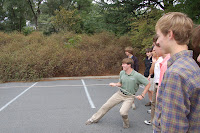In general physics, I do a bit more mathematical prep work as we move into forces at angles. But not much.
By now, my general physics students can deal with Newton's second law, as long all forces are either horizontal or vertical. For example, we do problems with cars slamming on the brakes, and slowing due to friction. Next, I want them to deal with forces at angles, like the lawnmower that's pushed along its handle.
We start the process of breaking vectors into components with displacement vectors, not force vectors. Why? Because students are familiar with the concept of cardinal directions and shortcuts: going 3 miles north and 4 miles west is the same thing as going 5 miles northwest, as long as you choose the angle correctly. Everyone gets that. If I can show them the mathematics in the context of displacement, then they can transfer those mathematics to force vectors.
Take a look at the assignment below. Note that Will Collier is a real student, whom I taught in 2001-02. He really does run a transport unit in Iraq, or at least he did last year. The rest of the exercise is merely convenient science fiction. I've done similar exercises before using maps of New York City, Berlin, and South Africa -- pick something of interest to one of your students!
Instructions for vector assignment:
Imagine that a new type of pilotless aircraft is developed. The plane is reliable and safe, yet inefficient; due to the vagaries of its design, this plane can fly ONLY along the cardinal directions: north, south, east, or west.
Will Collier, Woodberry class of 2002, runs a military transport unit. We will imagine that he has commandeered a large number of these aircraft to deliver goods throughout Iraq from a base in Baghdad. Your job as Lt. Collier’s unit navigator is to give directions to other Iraqi cities such that these special aircraft can fly there.
So, for each of the ten destinations you choose for Lt. Collier’s supplies, draw a displacement vector to the town.
Then, for each displacement vector, on unlined paper, using half a page per town, do the following:
• sketch the displacement vector and its components on x and y axes.
• state the magnitude and direction of the displacement vector.
• calculate the x and y components of the displacement vector, showing all work carefully as instructed in class
• write out, in words: "To fly to [whatever town], fly 200 km north, then 300 km west." Of course, fill in the correct distances and directions.
Follow these instructions (which are exactly what I said in class) carefully. I expect thorough, neat work. This should not take an exceptionally long time; work quickly but carefully. You should find this assignment to be the easiest all year. If you do not, come see me ASAP!




